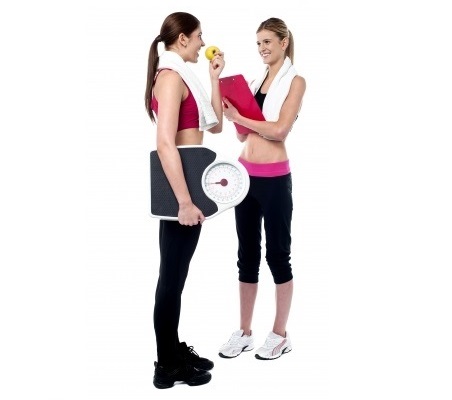Inaccurate Scales: A Weighty Problem For The Quantified Executive -Shelly Palmer

"I always say you shouldn't weigh yourself. I don't even have a set of scales in my house.[1]" - Kim Kardashian
Well, until yesterday, I didn't have a "set of scales" in my house either. But, as you can see, I do now. Wondering why?
In my quest to become a healthier, fit person, I have adopted the lifestyle of the healthier, fit person I want to become. For me, technology has been a magical key that has unlocked the secret to that lifestyle. The benefits have been weight loss, extra energy, a sense of well being and – as my daughter Alexis describes it – "charming Shelly," as opposed to the grumpy, cynical, curmudgeonly Shelly from days of old.
The good news is that my "behave like the person you want to be" philosophy does not require me to ever step on a scale. My weight loss (approximately 26 pounds so far) is a result of how I have chosen to live, eat and exercise. I'll stop losing weight when my body reaches the weight it wants to be. However...
I'm a huge geek (well, slightly less huge than I used to be), but a geek nonetheless. And, like I said, the key to my lifestyle change has been technology. Some people call it the "Quantified Self" movement; I'm calling it, "The Quantified Executive." No matter what you call it, here is how it works.
3,500 calories = 1 pound. Eat 3,500 calories more than you burn, you will gain a pound. Eat 3,500 calories less than you burn and you will lose a pound. The math is inviolate.
To make this equation actionable you need accurate measurement tools. For me, the routine is easy. I enter every single morsel of food I consume into the MyFitnessPal app on my smartphone. This gives me the best approximation of the amount of calories I consume.
I wear a Jawbone UP bracelet and I use two apps with it: the UP app, which measures my approximate calories burned from walking and gives its own version of interesting, but less useful, sleep tracking. And, I use RunKeeper to track my daily walks.
Using just these three apps, I've been able to quantify my behaviors – and, much more importantly, adapt my behaviors to my benefit. As a Quantified Executive, I know the power of data – so do you.
Which brings me to my "set of scales" problem. Part of the process of quantification is tracking results. I know that the calorie/weight equation is correct, but there are several variables in my process. Some days I eat bigger lunches or have to eat at a restaurant. The difference between the amounts of oil in two tablespoons of homemade salad dressing vs. restaurant salad dressing can be enormous. If you're trying to limit your caloric intake to 1,500/day, a wrong move or brain fade can cost you close to 10 percent of those calories (yes, in just two tablespoons of dressing).
My progress tracking method of choice has been the Withings WS-50 digital scale. It reports my weight to my smartphone and generates a bunch of less useful data like heart rate, estimated BMI and air quality. Having a digital scale that you can trust is great. I get on the scale every morning (when I'm home) and the app and associated website create a digital record of each event. Over time, a delightful graph is generated which illustrates my progress.
Now, one of the big problems facing the quantified self movement is that very few apps and devices speak the same language. There are no industry standards for measurement or easy ways to see all of your various activities tracked against each other. The answer, for me, and everyone else who is trying to quantify their lives, is Excel. I've created a spreadsheet that takes my caloric intake from MyFitnessPal, my estimated calories burned from UP, and my weight from my Withings WS-50 scale. I use the spreadsheet to track (and project) my progress.
In order to keep the data on this spreadsheet as meaningful as possible, I need accurate weight measurements daily. The problem is I spend my weekends in CT and my weekdays in NYC. The answer was simple. I purchased an additional Withings scale for CT. In this case, I purchased the WS-30, because the "extra" measurements available on the WS-50 are meaningless.
I was so excited (relatively speaking) by the prospect of weighing myself every day. That excitement didn't last long.
The first time I used the WS-30, the readings were about 1.3 pounds different from the previous day's readings taken by the Withings WS-50 and, sadly, had nothing to do with the old-fashioned digital scale that was already in the bathroom in CT.
To confirm my technology problem, I brought my WS-50 up from NYC so I could do a "three scale" showdown a few seconds apart. The results made me very sad:
224.2 - Withings WS-50
224.9 - Old-fashioned digital scale
225.7 - Withings WS-30

Now it's the end of August, and I'm down somewhere around 26 pounds since the beginning of May, so I can't really complain – but – a 1.3 pound differential in a world where I'm tracking and projecting .25, .33 and .50 pound per day reductions in weight, with a goal of 2 pounds per week (7,000 more calories burned than consumed), this kind of discrepancy is unacceptable in the extreme!
Is there a solution? Sure, just use one scale that you don't move and only weigh yourself once or twice per week. But, at least in the case of these two Withings scales – accurate (or calibrated to display the same weight regardless of actual accuracy) is not possible.
So, Quantified Executives beware – un-calibrated, inaccurate measurement technology, that is not designed to mix and match can be your undoing (did I hear someone say Nielsen, Arbitron, Rentrak, Google Analytics, Omniture, comScore, etc... oops!) It's a weighty problem indeed.
[1] Kardashian, Kim. "Brainy Quote." BrainyQuote. Xplore, n.d. Web. 29 Aug. 2013. <http://www.brainyquote.com/quotes/authors/k/kim_kardashian.html>.
Shelly Palmer is Fox 5 New York's On-air Tech Expert (WNYW-TV) and the host of Fox Television's monthly show Shelly Palmer Digital Living. He also hosts United Stations Radio Network's, Shelly Palmer Digital Living Daily, a daily syndicated radio report that features insightful commentary and a unique insiders take on the biggest stories in technology, media, and entertainment. He is Managing Director of Advanced Media Ventures Group, LLC an industry-leading advisory and business development firm and a member of the Executive Committee of the National Academy of Television Arts & Sciences (the organization that bestows the coveted Emmy® Awards). Palmer is the author of Television Disrupted: The Transition from Network to Networked TV 2nd Edition (York House Press, 2008) the seminal book about the technological, economic, and sociological forces that are changing everything, Overcoming The Digital Divide: How to use Social Media and Digital Tools to Reinvent Yourself and Your Career; (York House Press, 2011) and Digital Wisdom: Thought Leadership for a Connected World (York House Press, 2013). For more information, visit shellypalmer.com.
Palmer Digital Living Daily, a daily syndicated radio report that features insightful commentary and a unique insiders take on the biggest stories in technology, media, and entertainment. He is Managing Director of Advanced Media Ventures Group, LLC an industry-leading advisory and business development firm and a member of the Executive Committee of the National Academy of Television Arts & Sciences (the organization that bestows the coveted Emmy® Awards). Palmer is the author of Television Disrupted: The Transition from Network to Networked TV 2nd Edition (York House Press, 2008) the seminal book about the technological, economic, and sociological forces that are changing everything, Overcoming The Digital Divide: How to use Social Media and Digital Tools to Reinvent Yourself and Your Career; (York House Press, 2011) and Digital Wisdom: Thought Leadership for a Connected World (York House Press, 2013). For more information, visit shellypalmer.com.
Read all Shelly's MediaBizBloggers commentaries at Shelly Palmer Report.
Check us out on Facebook at MediaBizBloggers.com
Follow our Twitter updates @MediaBizBlogger
The opinions and points of view expressed in this commentary are exclusively the views of the author and do not necessarily represent the views of MediaBizBloggers.com management or associated bloggers. MediaBizBloggers is an open thought leadership platform and readers may share their comments and opinions in response to all commentaries.
[Image courtesy of cooldesign/FreeDigitalPhotos.net]


